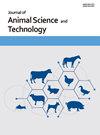Intestinal morphometric changes associated with the use of non-antibiotic feed additives in broiler chicks challenged with Salmonella Enteritidis
IF 3.2
3区 农林科学
Q1 AGRICULTURE, DAIRY & ANIMAL SCIENCE
引用次数: 0
Abstract
Non-antibiotic feed additives stand as a potential alternative for antimicrobial growth promoters, but their effects in the gastrointestinal tract of broiler chicks suffering early infection are poorly understood. This study aimed to investigate the effects of two non-antibiotic feed additives (a postbiotic and a sanguinarine-based phytobiotic) on the gut morphology and body weight gain of broiler chicks challenged with肠炎沙门氏菌攻毒肉鸡肠道形态变化与使用非抗生素饲料添加剂相关
非抗生素饲料添加剂是抗菌生长促进剂的潜在替代品,但其对早期感染肉鸡胃肠道的影响尚不清楚。本研究旨在研究两种非抗生素饲料添加剂(后生物制剂和以血碱为基础的植物制剂)对感染肠沙门氏菌/血清型肠炎(SE)的肉仔鸡肠道形态和增重的影响。采用完全随机设计,按2 × 3因子分布144只鸡,分别饲喂对照饲粮(SHAM-DCO)、益生菌后(SHAM-PFC)或以血碱为基础的复合物(SHAM-SAN)和对照饲粮(SE-DCO)、益生菌后(SE-PFC)和以血碱为基础的复合物(SE-SAN)。各组分别于接种后3、7、14天实施安乐死,采集标本进行SE计数和肠道形态测定。接种后14天测定体重增加。低(& lt; italic>术中;/ italic>≤0.05)<italic>沙门氏菌</italic>在接种后3天和7天分别观察含PFC饲料的雏鸟的计数。硒挑战雏鸡的隐窝深度更大(<italic>p</italic>≤0.05)和固有层厚度(<italic>p</italic>≤0.05)和更小的绒毛:隐窝比(<italic>p</italic>≤0.05)。总体而言,喂食PFC或SAN的鸟类显示固有层厚度减少(<italic>p</italic>≤0.05),绒毛高度较大(<italic>p</italic>≤0.05),绒毛:隐窝比(<italic>p</italic>≤0.05),绒毛面积较大(<italic>p</italic>≤0.05),与对照组(DCO)相比有显著差异。补充SAN可改善体重(<italic>p</italic>≤0.05)和体重增加(<italic>p</italic>≤0.05),直至孵化后14 d。两种饲料添加剂(PFC和SAN)都改善了鸟类对孵化后沙门氏菌的反应。肠炎感染,由肠道形态的有益改变证明。这些影响突出了这些饲料添加剂在饲养初期改善肉鸡肠道健康的潜力。
本文章由计算机程序翻译,如有差异,请以英文原文为准。
求助全文
约1分钟内获得全文
求助全文
来源期刊

Journal of Animal Science and Technology
Agricultural and Biological Sciences-Food Science
CiteScore
4.50
自引率
8.70%
发文量
96
审稿时长
7 weeks
期刊介绍:
Journal of Animal Science and Technology (J. Anim. Sci. Technol. or JAST) is a peer-reviewed, open access journal publishing original research, review articles and notes in all fields of animal science.
Topics covered by the journal include: genetics and breeding, physiology, nutrition of monogastric animals, nutrition of ruminants, animal products (milk, meat, eggs and their by-products) and their processing, grasslands and roughages, livestock environment, animal biotechnology, animal behavior and welfare.
Articles generally report research involving beef cattle, dairy cattle, pigs, companion animals, goats, horses, and sheep. However, studies involving other farm animals, aquatic and wildlife species, and laboratory animal species that address fundamental questions related to livestock and companion animal biology will also be considered for publication.
The Journal of Animal Science and Technology (J. Anim. Technol. or JAST) has been the official journal of The Korean Society of Animal Science and Technology (KSAST) since 2000, formerly known as The Korean Journal of Animal Sciences (launched in 1956).
 求助内容:
求助内容: 应助结果提醒方式:
应助结果提醒方式:


